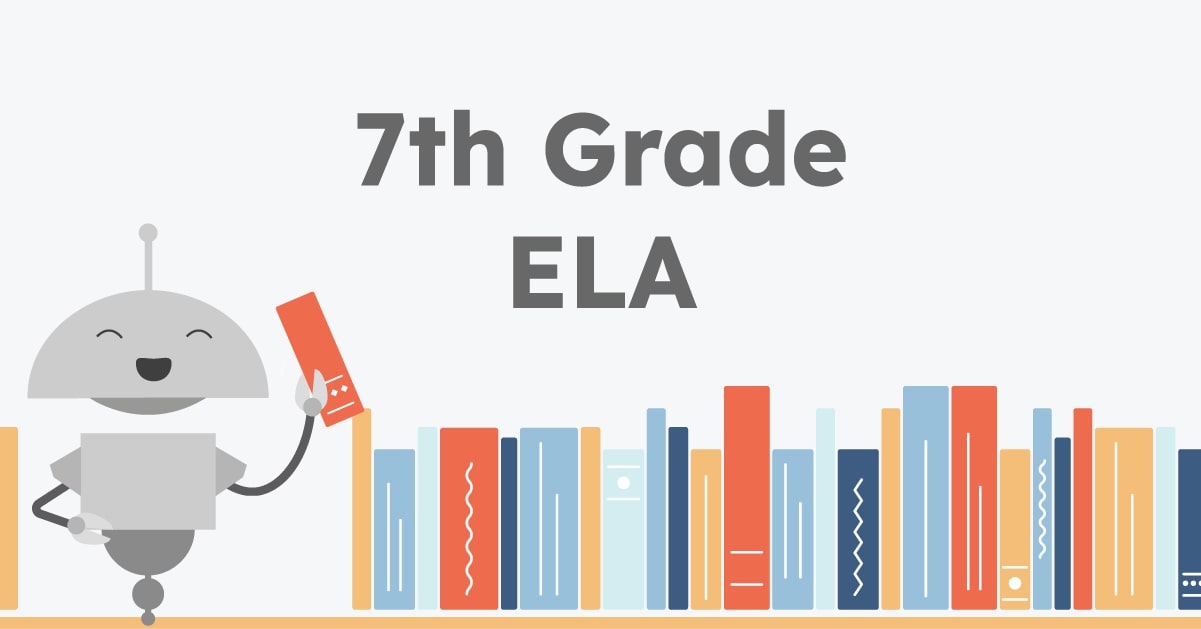7th Grade Language Arts Curriculum
Our seventh-grade language arts and reading comprehension courses are designed to strengthen student critical thinking, writing, and reading analysis skills through engaging, interactive, and age-appropriate content. Students dive into a wide range of text types while building vocabulary, refining grammar, and exploring key literary elements, all in one place!
Sample Lesson
Interested in more 7th grade ELA videos? Visit our YouTube channel @TheMiacademyLearningChannel!
Is my student ready for language arts in 7th grade?
Before working on seventh-grade reading and writing concepts, we recommend that your child complete our sixth-grade ELA courses.
Your student is likely ready for seventh-grade language arts if they can:
- Read and comprehend grade-level texts independently and with fluency.
- Identify main ideas and supporting details in both literary and informational texts.
- Make inferences and draw conclusions based on evidence from a text.
- Summarize texts concisely, focusing on central ideas and relevant details.
- Explain the meaning of words and phrases, including figurative and connotative meanings.
- Write multi-paragraph essays, including introductions, supporting body paragraphs, and conclusions.
- Use correct grammar, capitalization, punctuation, and spelling in writing.
- Understand basic parts of speech, sentence structure, and types of sentences.
- Participate in structured discussions, expressing ideas clearly and listening to others.
- Use reference materials, like dictionaries and thesauruses, to clarify word meanings.
Free ELA 7th Grade Worksheets – PDF Download
Each video lesson has an accompanying PDF with engaging activities to extend learning beyond the screen with a hands-on approach!
Click here to download a free sample PDF of our seventh-grade ELA worksheets:
What are the 7th grade ELA standards?
Seventh-grade language arts standards focus on building writing and analytical skills while teaching students more strategies to be thoughtful, careful readers.
By the end of seventh grade, students will be able to:
- Cite textual evidence to support analysis of fiction and nonfiction texts.
- Determine theme or central idea and explain its development over the course of a text.
- Analyze how elements like setting and plot influence characters and events.
- Interpret figurative language, connotation, and tone in a text.
- Compare and contrast texts, especially different forms or genres on the same topic.
- Write clear arguments and informative essays, using logical reasoning and relevant evidence.
- Conduct short research projects using multiple sources and proper citations.
- Use appropriate transitions, style, and tone in writing for different tasks and audiences.
- Participate in discussions, building on others’ ideas and expressing one’s own clearly.
- Demonstrate command of grammar, punctuation, and spelling in writing and speaking.
Standards can vary by state, so be sure to check what’s required where you live.
Scope and Sequence
7th Grade – Language Arts Level H
This course helps students grow their reading, writing, and critical thinking skills. Students will explore a range of genres, from fiction and nonfiction to poetry and multimedia, and learn how stories reflect culture and genre.
We recommend also adding our Daily Vocabulary Practice to boost your child’s communication skills! Regularly learning new words helps students understand what they read, write more clearly, and express themselves with confidence. Note: This practice is optional.
(7th Grade) Reading Comprehension: Level H
In this course, students read a mix of texts to build their comprehension skills and then check their understanding with a short, six-question quiz. It’s a great way to practice and strengthen what they’ve learned in their main Language Arts lessons.
Why is there more than one course?
Miacademy’s language arts curriculum is structured into three different courses, each that focus on a different set of skills:
Learn to Read (Levels A-C only): Focuses on letter sounds, rhyming, and common letter patterns to help kids practice reading for kindergarten to 2nd grade.
Language Skills (All levels): Covers comprehension strategies, grammar, and storytelling techniques to strengthen reading and writing.
Reading Comprehension (Levels C-I only): Provides weekly reading passages with questions to reinforce understanding and apply learned skills.
Students may work at different levels in each area to match their individual learning needs.
Miacademy’s Online 7th Grade Homeschool Curriculum
Our middle school ELA courses give students the right tools to be thoughtful readers and writers! By exploring a wide variety of texts and regularly applying what they’ve learned, students gain the skills,confidence, and clarity for more advanced language challenges.
Plus, one of the best things about our seventh-grade curriculum is homeschooling with flexibility! You get full customization over your lesson plans and assignments to fit your child’s unique learning needs. Students can skip what they already know and dive into new challenges!
Our family of accredited curricula covers everything from learning to read in elementary to analyzing literature in high school and adapts easily to different grade levels and learning styles.
Whether you’re a full-time homeschool parent or are looking to supplement a public school education, we’re here to support you! Wondering if Miacademy’s seventh-grade homeschool curriculum can be a good fit for your student? Start a chat with one of our friendly customer service agents below! They’ll be happy to help you with any questions you may have.



